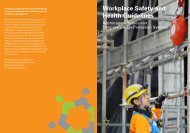Confined Spaces - Workplace Safety and Health Council
Confined Spaces - Workplace Safety and Health Council
Confined Spaces - Workplace Safety and Health Council
- No tags were found...
You also want an ePaper? Increase the reach of your titles
YUMPU automatically turns print PDFs into web optimized ePapers that Google loves.
It is also important to appoint a safety attendant to keep watch <strong>and</strong> continuously monitor theatmosphere so that it is maintained at acceptable/safe levels.It is essential to conduct regular leak tests for all valves, connectors <strong>and</strong> joints. The inspection willhelp to identify any worn out parts or any defects that would render them unfit for service <strong>and</strong>to repair or replace before the next use.In addition, it is essential to establish safe work procedures <strong>and</strong> implement them to ensure thatgas testing can be carried out safely without endangering the safety of the workers <strong>and</strong> otherworkers in the vicinity.11.3 Case 3: Toxic Poisoning in Food ReactorThe Incident:Two workers were tasked to clean a food reactor in the thermal processing room after theproduction of a food flavour. The food reactor was about 1.8 meters tall <strong>and</strong> they were washingthe internal wall from a st<strong>and</strong> outside the reactor.During the washing, one of the workers found a stubborn stain at the bottom of the reactor.After several attempts, he decided to climb inside the reactor to remove this stain. While he wascleaning, he complained of a strong smell <strong>and</strong> fainted inside the reactor 20 minutes later. In orderto rescue him, his co-worker climbed into the reactor. Immediately the co-worker felt difficulty inbreathing <strong>and</strong> fainted too. Both workers died in this incident.Findings:• A concentration of hydrogen sulphide (H 2S) was detected within the food reactor. H 2S couldbe formed under high temperature reactions during the manufacturing of food flavours.• The company did not implement a safe work procedure (SWP) <strong>and</strong> a permit-to-work (PTW)system for confined space work.• All workers were not trained in confined space work <strong>and</strong> no safety attendant was appointedto keep watch.• No risk assessment was conducted before the cleaning of the food reactor.• No suitable gas-testing instrument was available onsite so the food reactor had not beentested <strong>and</strong> certified safe for entry.• No ventilation <strong>and</strong> air monitoring were provided when the workers entered the foodreactor.Lessons Learnt:It is important for Management to show commitment <strong>and</strong> put in place an effective workplacesafety <strong>and</strong> health management programme. Through this, operations within the organisationwould be guided through a safety policy <strong>and</strong> establishment of a safety management system.Before carrying out any cleaning <strong>and</strong> maintenance of the reactor, it is important to conduct arisk assessment to identify <strong>and</strong> evaluate any possible hazards. It is necessary to put in place anyreasonably practicable control measures that will help to reduce the risk to an acceptable level.It is necessary to establish <strong>and</strong> implement lockoutprocedures for the cleaning <strong>and</strong> maintenance of the reactor.The food reactor is a pressure vessel with a steam jacket toraise the temperature during production. Therefore, it iscritical for the management to practice due diligence inensuring that the workers worked safely inside the reactor.It is also important to appoint a safety attendant to keepwatch <strong>and</strong> continuously monitor the atmosphere so that itis maintained at acceptable/safe levels.It is also important for workers who carry out cleaning ofthe food reactor to be properly trained <strong>and</strong> fully instructedon the potential hazards in connection with the work. It isalso necessary for them to put on appropriate protectiveequipment during the cleaning.In addition, it is essential to establish safe work procedures<strong>and</strong> implement them to ensure that food reactor cleaningcan be carried out safely without endangering the safety ofthe workers <strong>and</strong> other workers in the vicinity.Figure 32: Food reactor.11.4 Case 4: Death by SuffocationA worker was carrying out a visual inspection in the interior of the ISO tank to ensure that thetank was clean <strong>and</strong> free from residue. He was later found unconscious inside the tank by hisco-worker. The worker suffocated <strong>and</strong> was pronounced dead on the spot.Findings:• Nitrogen (N 2) was used to expel chemical di-octyl-phthalate (DOP) from the ISO tank <strong>and</strong>therefore the atmosphere inside the tank was filled with N 2.• The volume of the oxygen was found below 19.5%, therefore it was not safe for the worker towork under such conditions.• The company did not implement safe work procedures (SWP) <strong>and</strong> a permit-to-work (PTW)system for confined space work.• All workers were not trained in confined space work <strong>and</strong> no safety attendant was appointedto keep watch.• No risk assessment was conducted before the ISO tank inspection.• No suitable gas-testing instrument was available onsite so the ISO tank had not been tested<strong>and</strong> certified safe for entry.• No ventilation <strong>and</strong> air monitoring were provided when the worker entered the ISO tank.• No proper lighting was provided for the worker to carry out the tank inspection.Lessons Learnt:It is important for Management to show commitment <strong>and</strong> put in place an effective workplacesafety <strong>and</strong> health management programme. Through this, operations within the organisationwould be guided through a safety policy <strong>and</strong> establishment of a safety management system.82 83
















